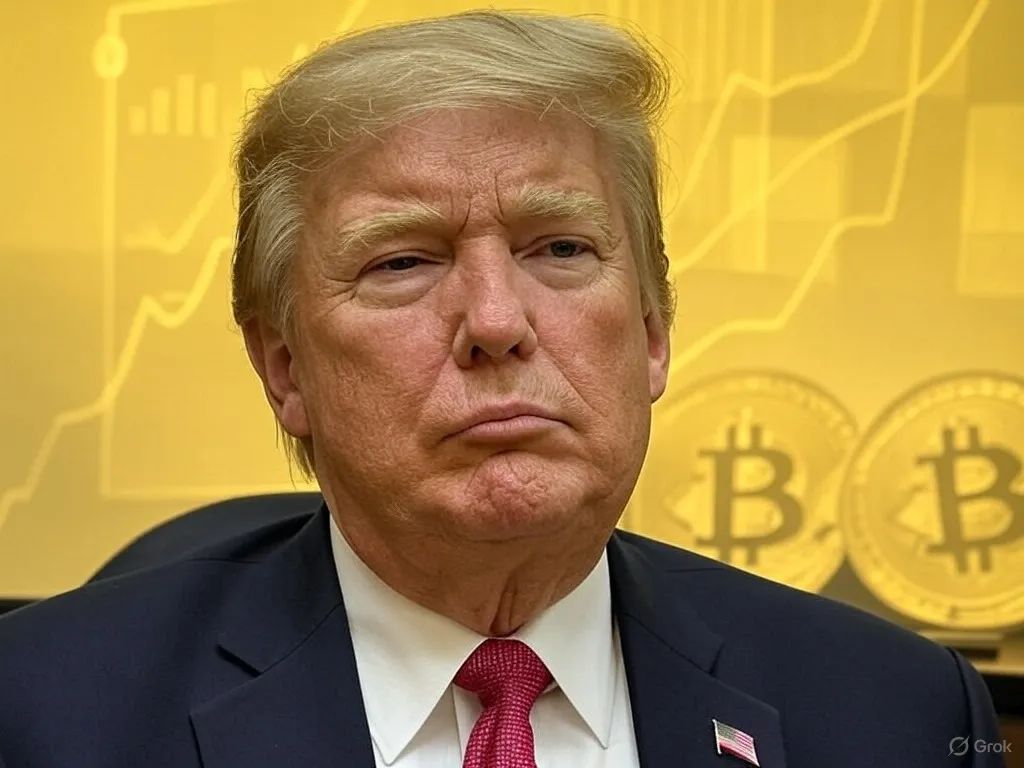By Ben Fairbank
Produced by|Baihua Blockchain
The crypto market is like a drunk, stumbling into 2025 on the heels of a late 2024 bull run that feels both familiar and fundamentally strange.
Headlines about Bitcoin breaking $100,000 by the end of 2024, memecoins surging like slot machines, and Donald Trump’s pro-crypto stance have ignited a feast that is as fascinating as it is disturbing, just like Beeple’s artwork.
Yet beneath the hype, this cycle is a chaotic hodgepodge of leverage mania, institutional restraint, and macroeconomic gambles that could propel markets soar or derail them. This is not the retail-driven FOMO frenzy of 2021, but a different beast, and the data bears out the chaos.
This bull market is unprecedented, and some controversial truths may make you rethink your position at the table.
01. Leveraged trading: From tools to casino drugs, Memecoin dealers are the winners
Leveraged trading is not new, but its scale today is shocking.
Leverage was just a side dish during the 2021 bull run, but now it is the main course, mixed with the Memecoin craze. Platforms such as Binance and Bybit reported a surge in leveraged trading volume, with Binance alone seeing $1.2 trillion in perpetual futures trading volume in the fourth quarter of 2024, up 60% from the 2021 peak.
Memecoin, the fallen darling of these crypto casinos, is the source of the spark, more fierce than the fuse that set off the Los Angeles wildfire. A 2025 survey by Security.org found that 68% of Memecoin traders admitted to losing money since entering the market, but they continued to increase their leverage by 50x and 100x like a dog head avatar influencer who was looking forward to winning the lottery. Why? Because Dogecoin reached $0.73 (market value of over $100 billion) and TRUMP tokens hit a peak of $15 billion in January 2025, which has turned trading into a dopamine factory.
This isn’t rational speculation, it’s slot machines dressed up as blockchain technology, where the house always wins. Every day we hear similar stories, like Chump, a 27-year-old trader who told Business Insider, “I love the thrill of watching the numbers go up.” He made $10,000 on Memecoin trades, but he was one of the lucky ones. Why are $10,000 trades worth reporting? Because they attract people who start small and bet big. Yet most people are losing money, and the leverage craze makes this bull market look like a circus on steroids.
02. Position size: Crypto leverage mathematics subverts traditional thinking
Things get even crazier, leveraged position sizes in crypto markets are quoted at full risk, a mind-boggling scenario not seen in traditional markets. A $4 million trade with 50x leverage? That’s $200 million in market exposure. In equities or forex, you’d only report $4 million in margin, not the amplified bet. This exaggerates the appearance and the risk.
Galaxy Research estimates that the notional value of the average leveraged position size in 2025 will be $5.2 million, up from $1.8 million in 2021. This is a huge leap, and the surge in this data has been driven by platforms throwing 100x leverage to retail investors like candy.
It is sensible for traditional markets to limit leverage to 10x, and the "full exposure" strategy in the crypto market is a marketing gimmick that turns traders into reckless gamblers. When Trump's big traders cashed out $109 million in two days (New York Times, February 2025), it was not a trick, but a leveraged lottery ticket. On the other hand, the counterparty of that trade lost $2 billion. This is not investing, I have said it many times before, this is a zero-sum bloodbath, and the data proves that it is bigger and uglier than ever before.
03. Institutions: Sitting on the Diaoyutai while the circus burns
Institutional investors, the so-called “smart money,” are not fooling around in this leveraged circus. BlackRock’s IBIT ETF holds 550,000 BTC, and hedge funds such as Millennium subscribed to $36 billion in Bitcoin ETPs in 2024 (Galaxy, 2025). But they are not chasing the 50-fold surge in Memecoin. Coinbase Institutional’s report points out that 82% of institutional crypto asset allocations in 2025 are long-term holdings, concentrated in Bitcoin, Ethereum, and perhaps Solana, focusing on the “strategic reserve” narrative rather than the depravity of short-term trading.
Unlike retail investors who panic sell every time there is a drop, institutions are gradually building positions. Why? Trump's Bitcoin reserve speech and ETF approval allow them to focus on the long-term prospects of 5-10 years rather than a quick doubling.
James Lavish of Bitcoin Opportunity Fund said it well at the 2024 New Orleans Investment Conference: "Bitcoin's shift from a speculative asset to a strategic asset" is real, and institutions are betting that it will surpass gold (currently about 11% of gold's market cap, changing daily). They will ride this bull run, but they won't get destroyed on leverage, which is the prerogative of retail investors.
04. Trump’s economic gamble: The coin toss of recession meets the big crypto moment

Fast forward to mid-2025, and the U.S. economy is on thin ice, with Trump holding the balance stick. An October 2024 report by Picton Mahoney estimated a 75% chance of a recession, due to a non-inverted yield curve, rising bankruptcies and a manufacturing downturn.
Trump’s response? Spending cuts, big tariffs, and a big bet on deregulation. It’s a big gamble that could crash the dollar or ignite a crypto supernova. If inflation soars (core CPI is already at 3.1%, above the Fed’s 2% target), Bitcoin’s “digital gold” narrative will get rocket fuel.
The timing is weird, with InvestingHaven’s timeline analysis predicting a massive bull run will peak mid-year (breakout in March-April 2025). But if Trump’s tariffs stifle growth and retail wallets are empty, the bull run could stall.
The data is mixed, with a Security.org survey showing that 60% of Americans who understand encryption believe Trump's return is good for encryption, but some people still have doubts about its security. This is not a simple catalyst, but a chaotic coin toss with global ripples.
05. Tariff Hedge or Collapse: Crypto’s Recession Script

Will Trump’s tariffs spark a crypto hedging boom, hamper the bull run, or make digital assets the ultimate safe haven? The data leans toward the latter.
Coincub predicts that stablecoin daily trading volume will reach $300-400 billion by the end of 2025, up from $100 billion in November 2024, as companies hedge foreign exchange risks.
The tokenization of real-world assets (RWAs, such as real estate, art, bonds) is exploding, with the market value expected to jump from $2.81 billion in 2023 to $9.82 billion in 2030 (Exploding Topics). Why? Liquidity and inflation resistance.
If the US economy stumbles, crypto's decoupling from the stock market (correlation drops to 0.3 in Q1 2025, according to Coinbase) makes it a magnet for capital flight. But the point is, retail investors are exhausted, and you and I know it. Economic stagnation could kill the FOMO fuel needed for past bull markets. This could be the first bull market where institutions, not retail investors, set the pace, which is really mind-boggling to imagine.
06. The road to redemption for retail investors: greed, regret and empty pockets
Talking to crypto veterans, the atmosphere is a mixture of post-traumatic stress disorder and cautious hope. Many people got greedy in 2021, experienced the crash, and now just want to "get their money back."
Some people have never returned after cashing out at the peak of 2021, I call them smart people. Others are still trading MeMe every day, chasing small wins of $500, while admitting that it is a "gambling addiction."
A HODL FM poll in 2025 found that 73% of long-term holders hope to at least get their money back in this cycle, but 40% have not re-entered the market since the bear market in 2022. The data is breathtaking.
The truth is that retail investors have no money. The funds for the bull market in 2021 are gone, and the household savings rate has dropped to 4.9% (Fed data), lower than the 7.5% before the epidemic. If this round of bull market is ignited, it is not due to the FOMO of parents, but institutional funds. Retail investors will either take the ride or be left behind. A bull market driven by pure institutions? Not only possible, but also very likely to be a reality.
07. Gambling can’t save us: where is the real fuel?
Desperation drove traders to leverage and Memecoin, but it wasn’t enough.
The $2.2 billion hacker loss in 2024 and the 19% of crypto holders being blocked from withdrawing funds are all sending out voices of distrust. Gambling on MeMe will not inject fresh capital into the market, it is just rearranging the deck chair numbers on the Titanic.
New money has to come from somewhere, like ETFs (Galaxy predicts $250 billion AUM), corporate coffers (MicroStrategy style), or countries (Trump's 207,000 BTC reserve plan). Without these, this bull market is just a mirage. Let's be realistic, right? So that we can get ahead of the curve and make money.
08. Open Creator Economy: A Global Marketplace in AI Recession

AI is rewriting the rules of the game, and this bull market may give birth to an open creator economy that transcends national boundaries. On-chain AI agents have surged, and Funds Society predicts that there will be 1 million of them by 2025, involving transactions, games, and building decentralized platforms.
What to trade in a recession? Data suggests: luxury goods (art NFTs up 45% in 2024), essential services (tokenized healthcare credits), and speculative assets (yes, Memecoin again). AI makes it scalable, think of teenage traders tokenizing TikTok influencers. It’s happening, I’m sure.
But it’s not all rosy. Masa’s analysis points to API limitations and data bottlenecks that could hamper growth. If successful, this bull run will be a global wealth transfer, not just a US party. If unsuccessful, we’re back to in-ring PVP.
09. Wealth Change: Patience Wins, Impatience Bleeds
Markets are Darwinian, and patience takes wealth from the impatient.
This bull run will see wealth transfer from leveraged retail investors to conservative investors. The cycle starts and ends with the same narrative, Memecoin fades and comes back.
InvestingHaven predicts that Dogecoin and Shiba Inu will rebound after the MeMe craze reaches its peak again. But the data is clear that 68% of Memecoin traders lose money.
Who are the winners? Institutions and veterans who quietly built up their positions.
10. Summary: Find your place when the music stops
This bull market is a mess, with crazy leverage, institutional restraint, Trump’s wild bets, and the coming creator economy.
It’s different because retail investors are going broke, institutions are restrained, and the world is watching an economic experiment that could make or break America.
The data screams volatility, but it also contains opportunities. Choose your position calmly and patiently. When the music can be withdrawn, only the patient ones will stay.












